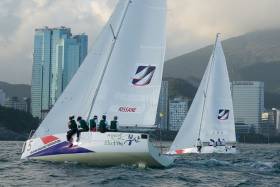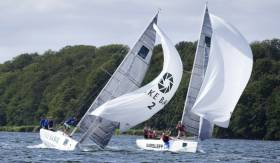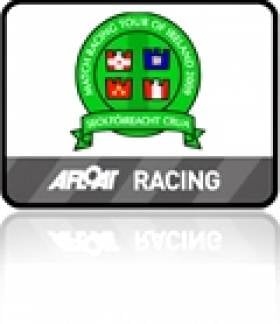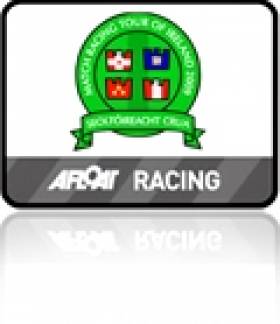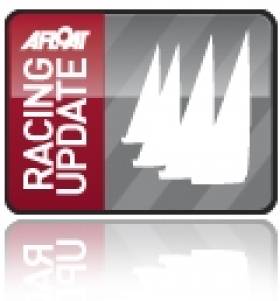Displaying items by tag: Diana Kissane
There was no place, unfortunately, for Howth Yacht Club's Diana Kissane in the quarter finals of the 2016 Busan Cup Women’s International Match Race Championships in Korea this week. The Dublin crew won two but lost nine in a highly competitive fleet. Lizzy McDowell, Isabella Morehead and Ellen Cahill were part of the KIssane crew line–up at the prestigious event.
Experience, experience and nothing but experience, that's what really counts when it comes to match racing, the chess game of sailing. And Claire Leroy has got loads of it, with two World Championship titles, several years as number one on the world ranking, and double triumphs in the Busan Cup Women's International Match Race under her belt. Now the French skipper has just won yet another round-robin. In Korea. With an impressive 9 - 2 score. Is she on her way to a third Busan title?
Claire Leroy and her Mermaid Sailing Team had a really successful Thursday on the waters just outside Haeundae Beach in Busan. The French team won six straight matches, and didn't lose a single one during the whole day. That perfect score took them all the way to the top of the leader board. In testing conditions with 20 knots of shifty and puffy breeze, combined with a lot of swell and some current.
The Busan Cup Women's International Match Race continues Friday with the quarterfinals, to conclude Saturday with semis and final.
Round-robin result in the Busan Cup Women's International Match Race, the 4th event of the 2016 WIM Series (name, nationality, wins - losses). The top eight advances to the quarterfinals:
1. Claire Leroy, FRA, 9 - 2
2. Lucy Macgregor, GBR, 8 - 3
3. Trine Palludan, DEN, 8 - 3
4. Anna Ostling, SWE, 8 - 3
5. Katie Spithill, AUS, 7 - 4
6. Stephanie Roble, USA, 7 - 4
7. Pauline Courtois, FRA, 6 - 5
8. Caroline Sylvan, SWE, 5 - 6
9. Renee Groeneveld, NED, 4 - 7
10. Diana Kissane, IRL, 2 - 9
11. Milly Bennett, AUS, 1 - 10
12. Gyeong Jin Lee, KOR, 1 - 10
10th Place For Howth's Kissane At Helsinki Women's Match
#MatchRacing - Howth Yacht Club's Diana Kissane and crew finished 10th in the first round of the Women's International Match Racing Series in Helsinki on Friday (1 July).
Kissane and crew Lizzy McDowell (Malahide YC), Isabella Morehead (Cork), Ellen Cahill (Mayo) won three of their 11 round-robin contests but it wasn't enough to take them through to the quarter-final knockout stage at the NJK Sailing Center, where the Swedish boat skippered by Anna Östling beat France's Pauline Courtois and crew in two straight races in the final.
As previously reported on Afloat.ie, the same venue in the Finnish capital is set to host the Women's Match Racing World Championship in 2017.
Howth Yacht Club's Diana Kissane Match Racing in Busan
Ireland's Diana Kissane is competing at the Busan Cup Women's International Match Race in Southern Korea. It was a tough round robin for the Howth Yacht Club sailor who won two of her 11 races that concluded the series for her today.
The Howth match racer has been on the international circuit racing this season and has already competed at the ISAF Women’s Match Racing Worlds in Middelfart, Denmark in July. Kissane's crew includes Aoife English, Bella Morehead, Jenny Andreasson and Lizzy McDowell.
With three more wins in Friday’s racing in the Busan Cup Women’s International Match Race, Anne-Claire Le Berre of France went to 10 – 1 and winning the round-robin stage. The fight for the 2015 WIM Series title will now heat up, as World #1, but Series’ runner-up, Camilla Ulrikkeholm Klinkby chose American leader Maggie Shea in the quarters:
“We want to be able to do the job ourselves. Beating Maggie is the only way we can take the WIM Series” the Dane states.
“We had a good race against Camilla in the round-robin, and we’re happy to see her again” Shea replies.
Friday morning saw a short postponement at the Busan Cup Women’s International Match Race, the fourth and final event of the 2015 WIM Series, as Regatta Director Alfredo Ricci moved the course from just off of Haeundae Beach to an area closer to the Gwangan Bridge. After just a few minutes with the AP flag flying from the committee boat, the starting sequence commenced in 5 – 7 knots of shifty and puffy breeze, which built to 8 – 12 knots at midday. The shoreline skyscrapers also affected the already unsteady wind:
“It wasn’t that difficult today, as we could clearly see the puffs come rolling down the course, read the wind quite easily and adapt to it” Le Berre comments.
The French World #4 won all three of her Friday matches, finishing the day by defeating compatriot Pauline Courtois, who badly needed a win in that last race to qualify for the quarterfinals:
“We must sail our own race and can’t take into account if the opponent is French or not. We want to win the round-robin, to be able to choose ourselves whom to meet in the quarters” Le Berre explains.
Previously undefeated Katie Spithill saw her first two setbacks today, against Ulrikkeholm Klinkby and Dutch Renée Groeneveld, to finish round-robin runner-up on a 9 – 2 score. But the Aussie wasn’t too upset about her lost matches:
“We made a few mistakes, but it’s better to do them now than later on in the regatta. Pretty much we lost those matches already on the starting line, so we’ll need better prestarts” Spithill analyses.
“It’s a new scorecard now. We’re looking forward to the weekend, and we’re excited to get racing tomorrow” she fills in.
Maggie Shea, substituting for regular Epic Racing skipper, World #2 and WIM Series leader Stephanie Roble, had a tough Friday on the Korean waters, adding two losses to her round-robin score, totalling 7 – 4:
“It wasn’t our best day of racing, but we learned a lot. Actually I’m thankful for the close racing and for the situations that occurred, it’ll help us improve for the weekend” the American skipper says.
Especially grateful for the US mistakes is local hope Sung-Eon Choi, who took her first bullet in her home event by defeating Shea & Co:
“We did a very good start and led all the way around the course, to finish about three boat lengths ahead of the Americans. It was a great feeling!” Choi laughs.
Quarterfinals and semis are planned for Saturday, leaving the final races for Sunday. Three skippers can still win the 2015 WIM Series; Roble/Shea, Ulrikkeholm Klinkby and Swede Anna Östling.
Results in the round-robin of the Busan Cup Women’s International Match Race, the fourth and final event of the 2015 WIM Series (skipper, nationality, wins – losses):
1. Anne-Claire Le Berre, FRA, 10 – 1
2. Katie Spithill, AUS, 9 – 2
3. Camilla Ulrikkeholm Klinkby, DEN, 8 – 3
4. Maggie Shea (substituting for Stephanie Roble), USA, 7 – 4
5. Caroline Sylvan, SWE, 7 – 4
6. Anna Östling, SWE, 6 – 5
7. Renée Groeneveld, NED, 4,5 – 5
8. Denise Lim, SIN, 4 – 7
9. Pauline Courtois, FRA, 4 – 7
10. Milly Bennett, AUS, 3 – 8
11. Diana Kissane, IRL, 2 – 9
12. Sung Eun Choi, KOR, 1 – 10
#matchracing – Howth's Yacht Club's Diana Kissane faces strong opposition in Denmark at the Women's Match Racing World Championship and yesterday strong gusts and a long day conspired to really test the sole Irish entry who sustained six losses, the same as Finnish and Dutch entries
Local hope Lotte Meldgaard and French Anne-Claire Le Berre are the only undefeated skippers after the opening day of the 2015 ISAF Women's Match Racing World Championship, the first event on the 2015 Women's International Match Racing Series (WIM Series), in Middelfart, Denmark. Both scored 8 - 0 on a long and very action-packed Wednesday:
"Even with one reef in the main and a smaller jib replacing the genoa, the Match 28's we're racing here are quite overpowered. We lost control a couple of times, but excellent crew work got us back on track again" Meldgaard comments.
The opening day offered truly challenging conditions for the competitors as well as for the race management. Gusts approaching 30 knots swept down the course, leaving broaching boats, freely flying kites and wet and exhausted sailors behind.
The racing in Middelfart continues with the round-robin Thursday and Friday, while the weekend will see the exciting knock-out rounds to crown the World Champions.
Standings after one day of round-robin in the 2015 ISAF Women's Match Racing World Championship in Middelfart, Denmark, the first event on the 2015 WIM Series (skipper, country, wins - losses):
1. Lotte Meldgaard, DEN, 8 - 0
1. Anne-Claire Le Berre, FRA, 8 - 0
3. Anna Östling, SWE, 7 - 1
4. Camilla Ulrikeholm, DEN, 5 - 1
4. Caroline Sylvan, SWE, 5 - 1
6. Stephanie Roble, USA, 4 - 2
6. Klaartje Zuiderbaan, NED, 4 - 2
8. Pauline Courtois, FRA, 5 - 3
8. Katie Spithill, AUS, 5 - 3
10. Milly Bennett, AUS, 3 - 5
11. Louise Christensen, DEN, 2 - 6
12. Johanna Larsson, SWE, 0 - 6
12. Nina Ramm-Schmidt, FIN, 0 - 6
12. Rikst Dijkstra, NED, 0 - 6
12. Diana Kissane, IRL, 0 - 6
16. Sanna Hager, SWE, 0 - 8
#matchrace – Howth Yacht Club's Diane Kissane and her crew are competing at this week's ISAF Women's Match Racing World Championship in Denmark, as Afloat previously reported back in May. Warm and sunny conditions with a strong southerly breeze today welcomed the 81 sailors participating in the 2015 ISAF Women's Match Racing World Championship, the first event out of four on the 2015 Women's International Match Racing Series (WIM Series), to Middelfart, Denmark. The rain waited politely until the last practise session in Match Racing Denmark's fleet of Match 28 boats was over:
"It takes a while to learn a new boat, but we've also had some practise on our home waters and feel quite confident going into this event," says World # 1 and defending World Champion Anna Ostling.
During Tuesday's practise session in Middelfart the Swedish crew of Team Anna had a few great fights against last year's World Championship bronze medallist and WIM Series # 4, American Stephanie Roble of Epic Racing:
"It's a shifty and tricky venue and we were happy to be controlling the Swedes a lot of the time. I like the boats a lot, they spin quickly and it's good to be five on board," Roble comments.
By Sunday we'll not only know which of the top ranked sailors has captured the World Championship title, but also who gained points on this first event out of four on the 2015 WIM Series. The first two years of the WIM Series saw 39 professional teams from 19 countries competing for gold and glory.
2015 ISAF Women's Match Racing World Championship teams (skipper, country, ISAF World Ranking):
Anna Ostling, SWE, 1
Camilla Ulrikkeholm, DEN, 2
Stephanie Roble, USA, 3
Anne-Claire Le Berre, FRA, 4
Lotte Meldgaard, DEN, 5
Caroline Sylvan, SWE, 6
Klaartje Zuiderbaan, NED, 7
Pauline Courtois, FRA, 8
Milly Bennett, AUS, 9
Johanna Larsson, SWE, 13
Nina Ramm-Schmidt, FIN, 14
Katie Spithill, AUS, 16
Sanna Hager, SWE, 17
Rikst Dijkstra, NED, 18
Diana Kissane, IRL, 60
Louise Christensen, DEN, 6
#MatchRacing - Ireland's Diana Kissane will skipper a team in the upcoming Women's International Match Racing Series, how entering its third year of competition.
The Howth Yact Club match racer leads one of the 20 teams already confirmed for the new season, which kicks off 47 days from now at the ISAF Women’s Match Racing Worlds in Middelfart, Denmark from 8-12 July.
That will be followed by the Lysekil Women’s Match in Sweden on 3-8 August, the Buddy Melges Challenge in Sheboygan, Wisconsin on Lake Michigan on 16-20 September, and the Busan Cup in South Korea from 28 October to 1 November.
But first things first, Danish skipper Camilla Ulrikkeholm will be looking to avenge her team's loss to Anna Östling (neé Kjellberg) at the 2014 ISAF Match Racing Worlds in Cork Harbour last June.
“We are never in it not to win it. We will fight for every win this year, as every year,” says Ulrikkeholm, who will have the advantage of home waters for the WIM Series kickoff.


























